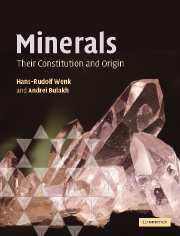Book contents
- Frontmatter
- Contents
- Preface
- Acknowledgments
- Figure credits
- Part I Structural features of minerals
- Part II Physical investigation of minerals
- Part III Variety of minerals and mineral-forming processes
- Part IV A systematic look at mineral groups
- Part V Applied mineralogy
- 30 Metalliferous mineral deposits
- 31 Gemstones
- 32 Cement minerals
- 33 Minerals and human health
- 34 Mineral composition of the solar system
- 35 Mineral composition of the earth
- Appendices
- Glossary
- References
- Index
- Plate section
- References
32 - Cement minerals
from Part V - Applied mineralogy
- Frontmatter
- Contents
- Preface
- Acknowledgments
- Figure credits
- Part I Structural features of minerals
- Part II Physical investigation of minerals
- Part III Variety of minerals and mineral-forming processes
- Part IV A systematic look at mineral groups
- Part V Applied mineralogy
- 30 Metalliferous mineral deposits
- 31 Gemstones
- 32 Cement minerals
- 33 Minerals and human health
- 34 Mineral composition of the solar system
- 35 Mineral composition of the earth
- Appendices
- Glossary
- References
- Index
- Plate section
- References
Summary
Significance of cement
Concrete is the most widely used structural material in the world today. Each year 1 billion tonnes of Portland cement are converted into 11.5 billion tonnes of concrete at a value of 90 billion US dollars, more than one tonne for every human being. This is about five times the tonnage of steel consumption. Even though concrete is considerably weaker than steel, it is preferred for several reasons. One reason is its excellent resistance to water. Some of the earliest applications were in the construction of aqueducts and waterfront retaining walls by the Romans. Today it is widely used in the construction of dams and offshore oil platforms, for example in the North Sea. A second reason is the ease with which concrete can be formed into almost any shape and size. Freshly made concrete is of a plastic consistency and can be poured into any prefabricated form. After a few hours it solidifies into a hardened and strong mass. Finally, at about $US 20 per tonne, concrete is the cheapest and most readily available building material, compared for example with steel ($US 500 per tonne).
Concrete is a composite material that essentially consists of a binding medium or cement that is combined with fragments of rocks, the so-called aggregate (Figure 32.1). The aggregate is granular material such as sand, gravel or crushed rock. There are two types of cement, hydraulic and nonhydraulic.
- Type
- Chapter
- Information
- MineralsTheir Constitution and Origin, pp. 550 - 557Publisher: Cambridge University PressPrint publication year: 2004



